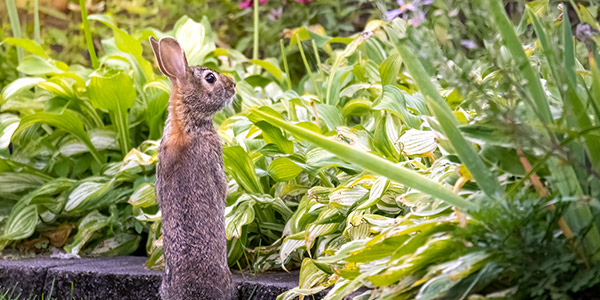Homeowners
Keeping Your Yard From Becoming an All-the-Bunnies-Can Eat Buffet
March 30, 2018
The care and attention you show your lawn, flowers, vegetables, or other landscaping plants can draw more than the appreciation of your neighbors. It can also make them quite inviting to hungry rabbits, not to mention deer, field mice, moles, cats, and raccoons. Having both a lovely yard and deterring wildlife from treating it like an all-you-can-eat buffet can be accomplished with a little preventive care.
Setting Boundaries
One of the first lines of defense is, well, a fence. High fences can be effective enough to send larger animals looking elsewhere for their next meal. You can also use rocks or netting to fill in any gaps between the bottom of the fence and the ground.
Within your yard or garden, raised beds with a bottom layer of mesh can keep out smaller critters. Another option is to cover plants with garden netting to keep furry friends from enjoying ripening tomatoes before you do.
Making Scents
Scents are a powerful form of communication in the animal kingdom. You can use this fact to your advantage by strategically placing aromatic warning messages throughout your yard. Orange and lemon peels, as well as coffee grounds, are known to discourage cats from lingering, while essential oils like lavender, mustard, and citronella can be effective in repelling deer. There are also many scent-based commercial products available. These include predator scents, which will make animals wary of your outdoor area. However, doing some research is advised to ensure you're getting the most effective aroma for whatever you're trying to keep away.
Unappetizing Tastes
Should a four-legged trespasser persist, using a less-than-tasty repellant can discourage repeat visits. While many commercial options are available, including spicy-pepper-based granular repellants that can be used to create a barrier around specific areas, spraying a homemade solution of hot sauce and water directly onto plants, fruits, and vegetables has also been known to do the trick.
Keeping an Eye—and Ear—Out
Sometimes, all it takes is a well-placed sight or sound to scare off stray wildlife. Hanging a string of cans, pie plates, or even CDs in an area that would be disturbed by scurrying will make a lot of rackets or, in the case of the CDs, cause a shiny, unexpected, and startling movement that will discourage raccoons, which like to sneak through yards undetected. You can also purchase motion-activated sprinklers or ultrasonic noise repellants, emitting frequencies mice, moles, and other small critters find unpleasant. Posting white flags around your garden or yard gives the illusion of white-tailed deer running, which other animals may take as a sign of fleeing from an approaching predator…though your neighbors might think you are surrendering!
Live Traps
When dealing with a produce thief who won't take a hint, live trapping followed by physical relocation may be an option. Often, the key to the effectiveness is the bait you use. For example, peanut butter tends to be universally irresistible. Check local regulations when it comes to relocating an animal. In some states, like California, it's against the law for residents to relocate "nuisance animals." When in doubt, you can always call in accredited professionals.
Animals are smart, especially when hungry, so vary your methods. However, the humane approach to discouraging uninvited visitors helps ensure the neighborhood bunnies will keep hopping along a different path.




